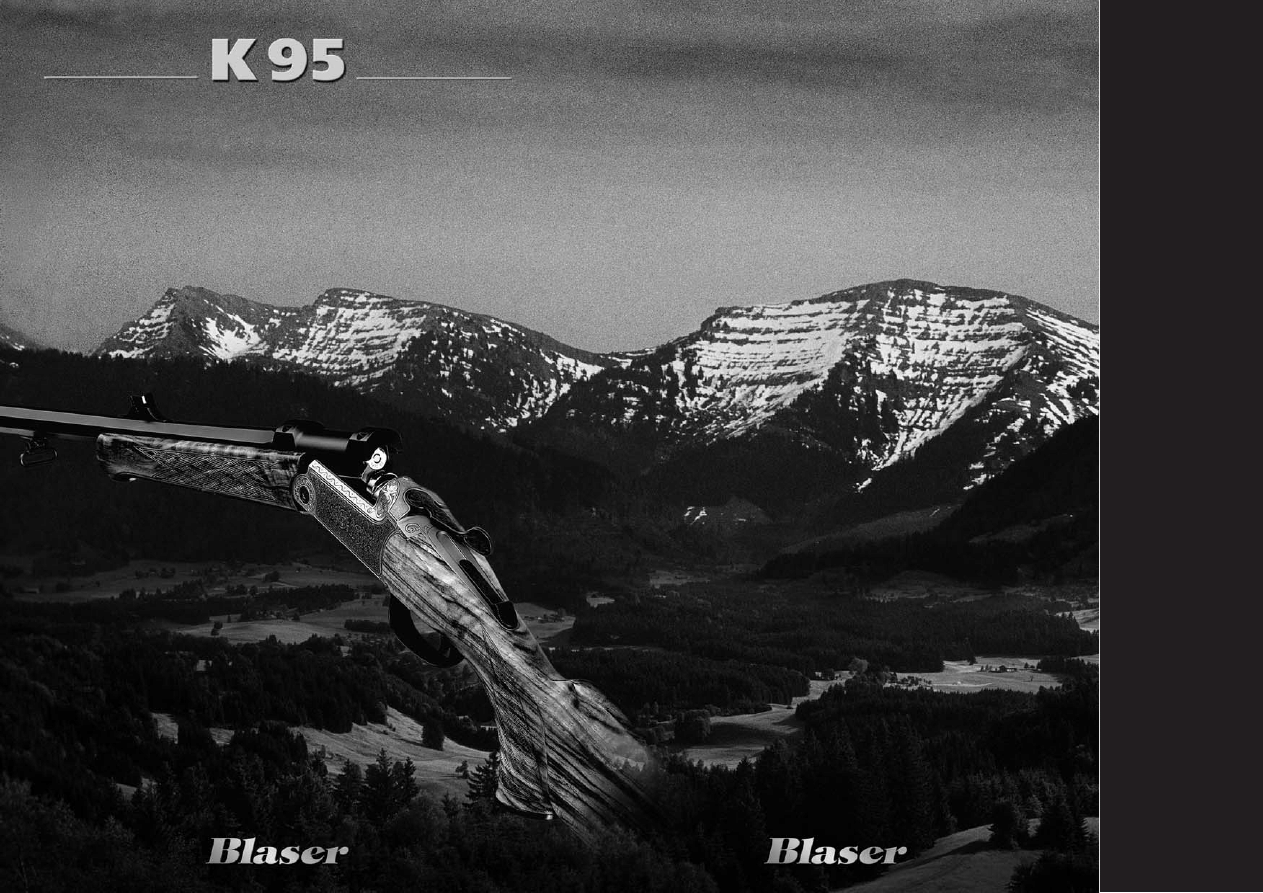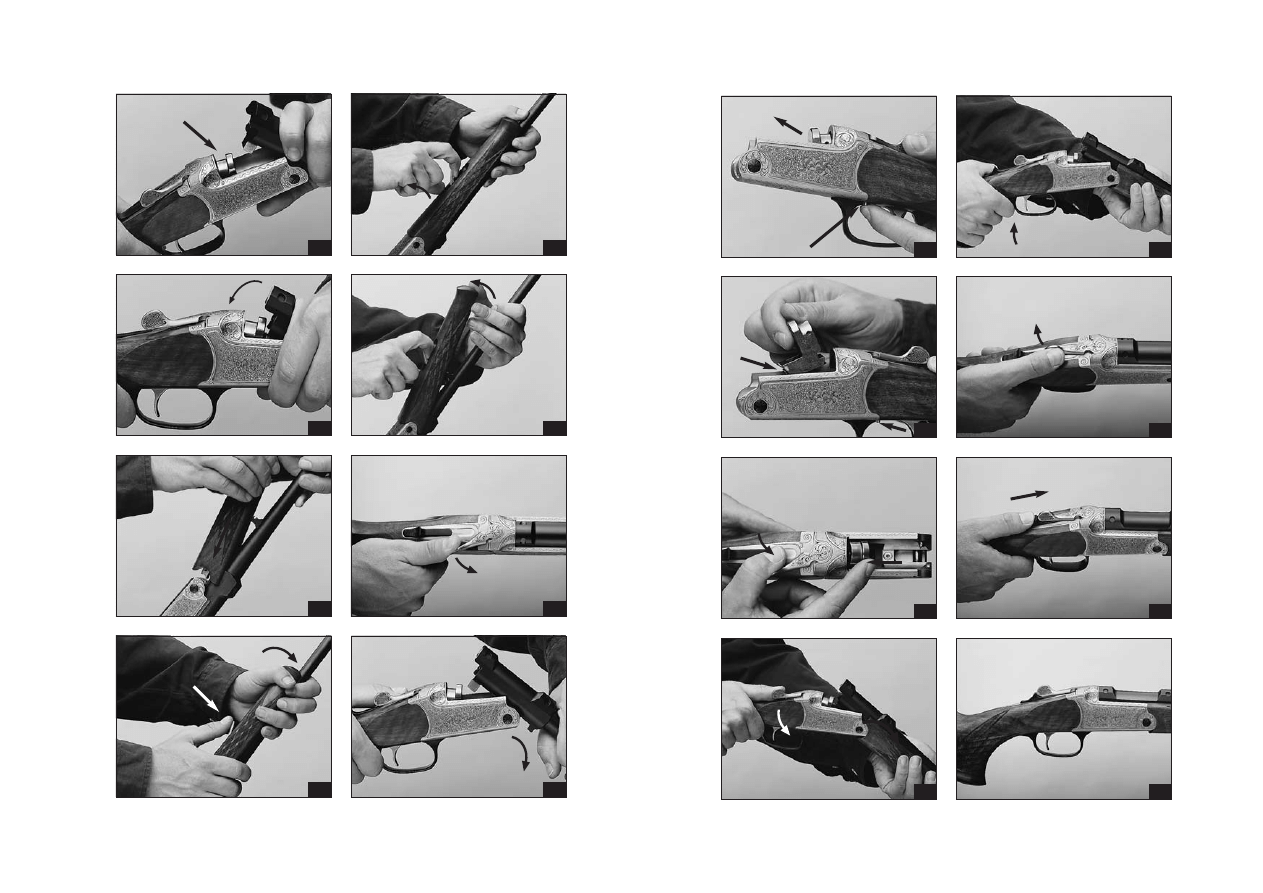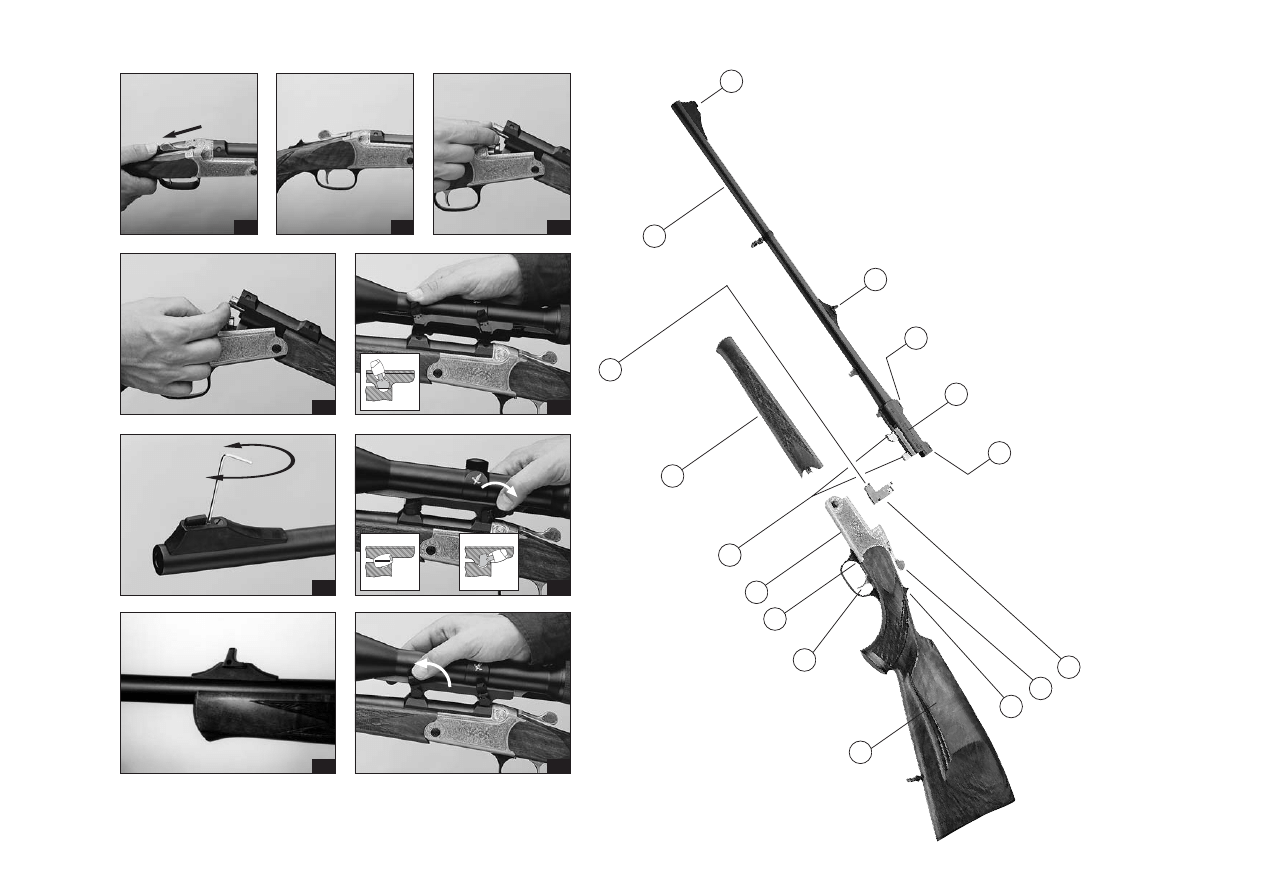
Blaser Jagdwaffen GmbH
D-88316 Isny
Germany

1.2.
2.1.
1.1.
2.1.
1.1.
2.2.
1.2.
2.2.
2.3.
3.2.
2.4.
3.2.
2.4.
4.1.
3.1.
4.1.
10
10
15

8.2.
4.2.
4.2.
5.1.
7.1.
8.1.
9.2.
9.1.
9.1.
1
2
3
3
4
5
6
7
8
9
10
11
12
13
14
15

12
Table of Contents
Description of Parts
1
Foresight
2
Rear sight
3
Seats for original Blaser
saddle mount (DBP)
4
Indication of model and calibre
5
Breech block
6
Locking lever
7
Safety slide (cocking slide)
8
Buttstock
9
Trigger
10
Block lock
11
Receiver
12
Barrel hook
13
Forearm
14
Barrel
15
Shaft bearing
Instruction manual
1
Page
Description of Parts
1
General Safety Rules
2/3
1. Assembly of the Rifle
4
2. Disassembly of the Rifle
5
3. Opening and Closing the Rifle
6
4. Safety
7
5. Loading the Rifle
8
6. Firing
8
7. Unloading the Rifle
9
8. Open Sights
9
9. Mounting of Scope
10
10. Case
11
11. Care and Maintenance
11
12. Warranty Conditions
12
12. Warranty Conditions
1. Manufacturer’s warranty
Warranty of Blaser Jagdwaffen GmbH is provided
in addition to statutory warranty claims by dealers,
provided, that the enclosed firearms certificate is
filled in completely and received by Blaser Jagd-
waffen GmbH within ten days after the date of
sale. Warranty is provided exclusively for the first
purchaser having his residence in the country of
purchase.
The warranty applies to the metal and plastic
parts of the rifle only, including original Blaser rifle
scope mounts, but not the rifle scope. Wooden
parts of the rifle require special care and, being
natural products, are subject to natural changes.
Warranty for wooden parts is excluded.
The warranty period amounts to ten years, star-
ting with the date of sale. It includes any defects
of and damages to the rifle (metal and plastic
parts), which are proven to be due to faulty mate-
rial or manufacturing. Within this framework, the
manufacturer shall bear the costs for material and
working time. For performance of work under
this warranty, the rifle has to be returned to the
specialised dealer or the production company in
Isny.
Risk and costs of transportation of the rifle (out-
ward and return) shall be borne by the customer.
Warranty is performed in the discretion of manu-
facturer by repair or replacement of defective
parts; replaced parts pass into manufacturer’s
property.
2. Warranty for gun efficiency
The firing precision of a gun depends on a multi-
tude of factors. The most important factor is the
ammunition. Not every barrel fires equally well
with every type of ammunition, there may be con-
siderably differences in efficiency. The scope and
its mount are of the same importance. Parallax,
loose reticles, defects in reticle adjustment and
faulty mounting are the most common causes for
unsatisfactory gun efficiency. For these reasons,
you should use branded scopes, mounted by a
specialist, and you should tune in the ammunition
to your rifle by testing several types of ammunition.
Ammunition of the same make and charge may
exhibit different efficiency and impact point
characteristics from one manufacturing run to the
other and from one rifle to the other.
When the optimum of ammunition, rifle scope
and mount were selected, we provide a warranty
for the excellent efficiency of our rifles.
Complaints regarding gun efficiency have to be
brought forward in writing within 20 days after
the date of sale. We reserve the right to submit the
rifle to an independent institution for verification
(DEVA or Staatliches Beschussamt) [government
proofhouse]. If excellent gun efficiency is confir-
med there, we are entitled to claim the costs
incurred for the tests from customer.
3. Scope of warranty
Work performed under warranty does not cause
any prolongation or renewal of the warranty period
for the rifle or built in spare parts. The warranty
period for installed spare parts ends at the same
time as the warranty period for the entire rifle.
4. Guarantee exclusion
The guarantee shall be excluded with:
• Damage that is caused as the result of normal
wear and tear, with non-observance of the ope-
rating instructions or improper use or handling
and if the gun shows mechanical damages of
any kind.
• Damages that are the result of force majeure
or environmental influences
• Repairs, treatment or changes to the gun
performed by third parties
• Use of reloaded or non-CIP-permitted
ammunition
• Blueing carried out by a third party
The guarantee does not apply for optical sight
equipment and telescopic sight mounts of manu-
facturers other than Blaser Jagdwaffen GmbH.
More extensive or other claims, especially those
that refer to compensation for damages that go
beyond the gun itself (consequential damages)
shall be excluded (provided liability is not legally
ordered as compulsory).
12-2004 Subject to technical modifications

3
General Safety Rules
General Safety Rules
2
Your new Blaser breakdown rifle K 95 is
characterised by special design features,
making it very different from other break-
down rifles. The enhanced safety features
of your Blaser rifle however, should never
induce you to ignore the necessary care and
legal provisions with respect to handling
arms.
Please check first, whether you have the
correct operating instructions: The model
name K 95 and the calibre indication are
marked on the left side of the barrel, at the
back.
CAUTION:
Please read these operating instructions
completely, before using the rifle. Only
hand on the rifle together with the opera-
ting instructions.
Please ask your specialised dealer for an
in-depth explanation of your rifle and
instruction in its use, as a supporting
measure to these operating instructions.
General safety rules
for handling firearms
– Ensure that firearm and ammunition never
pass into the hands of unauthorised
persons.
– Always keep firearm and ammunition se-
parate, in a secured unit and inaccessible
to unauthorised persons.
– Observe applicable legal provisions
for carrying and storing arms and
ammunition.
– Familiarise yourself thoroughly with the
handling of your firearm and practise all
functions and actions with the firearm
unloaded, before starting to carry and
use it.
– Consider every firearm as loaded and
ready to fire, unless you have convinced
yourself of the contrary by opening
the action and checking the chamber
(barrel). Even when unloaded, a firearm
has to be handled like a loaded firearm.
– During any handling, always hold the
muzzle in a direction where you can
neither jeopardise nor damage persons
or property.
– Before loading the firearm, always check,
whether there are oil residues or other
foreign matter in the chamber or barrel.
Oil residues in chamber or barrel may
cause distinct shifts in the point of impact!
Foreign matter in the barrel (e.g. water,
snow, soil) may cause a detonation of
the barrel, leading to severe injuries of
the shooter or persons in the vicinity!
Ensure that no foreign matter can enter
the barrel, also during use!
– Only use ammunition which meets the CIP
requirements, in particular with regards to
the maximum gas pressures P
max
according
to CIP regulations. Every Blaser rifle is
controlled and tested by the state proof-
house according to the requirements of
the proofing-law and -regulations, using
proof cartridges exceeding the maximal
allowed gas pressure P
max
by a minimum
of 30%. If gas pressures exceed proof-level,
the safety of the user and/or third parties
can no longer be guaranteed. The same
applies to cartridge cases, where the seal
function is no longer correct through
obturation.
– Load your firearm only immediately
before use.
– Disengage from safe position (cock) your
firearm only immediately before shooting.
Hold barrel into a direction out of danger
during disengaging (cocking).
– Check the surrounding area, before
every shot.
– Point your firearm only at a target,
which you have clearly identified.
– Only put your finger on the trigger,
when you want to shoot.
– Only fire a shot, when a secure back
stop exists.
– When a cartridge fails, wait approx.
60 seconds before opening the action,
to avoid danger through hang-fire.
– Wear hearing protection during shooting.
Unload your firearm:
– before
crossing
obstacles,
– before climbing and leaving raised hides,
– before entering a building,
– before climbing into a vehicle,
– before entering a built area,
– and also, when you lay down or
hand on the firearm temporarily.

5
2. Disassembly of the Rifle
4
1. Assembly of the Rifle
Securing barrel
(Only possible with forearm removed)
• Pull out extractor all the way to the stop.
Do not touch locking lever.
• Seat the front barrel hook onto the hinge
bolt. Due to the tight fit, this requires care.
• Grip around barrel hook part and receiver
with one hand, press barrel hook into its
seat, closing the rifle.
CAUTION:
The breech block must be in its correct posi-
tion (slightly inclined forwards). Should the
block be in vertical position, the barrel can-
not be closed. In this case, press the locking
lever all the way to the right and, with your
other hand, return the breech block into its
forward inclined position.
NOTE:
Securing the barrel requires a certain amount
of skill. Do not use force! We suggest having
this procedure demonstrated by an expert
and practise several times in his presence.
1.1.
Installing forearm
• Engage forearm on hinge bolt, flush with
the receiver, and tilt it onto the barrel,
until it reaches the stop.
• The best manner to do this is to lift the
forearm shutter with your index finger
and hold it in this position.
• Press in forearm.
• The forearm flap engages.
• Close the forearm flap completely.
The forearm is now locked.
1.2.
CAUTION:
Unload your rifle before disassembly
(refer to page 9).
Removing forearm
• Support the rifle at the buttstock on your
thigh.
• Pull forearm flap out with a finger of one
hand, and disengage forearm from the
barrel by pressing with the fingers of your
other hand.
• Tilt forearm away from barrel at a slight
angle and pull it up, removing it from the
hinge.
Removing barrel
(Only possible with forearm removed)
Press locking lever all the way to the
right and hold it in this position.
Tilt barrel all the way down.
Doing so, the barrel hook is disengaged.
2.2.
2.1.
Removing breech block
(with barrel unhinged)
This is only necessary, when you want to
thoroughly clean the rifle or safeguard it
against unauthorised use by removing the
breech block.
• Press block lock 10 , located beside
the trigger, and keep it pressed down.
• Now press the locking lever simultaneously
to the right, until breech block disengages.
• When disengaging, the block snaps for-
ward a little and can now be removed,
accessing it from the front.
Reinstalling breech block
• Put breech block with the semicircular
shaft bearing 15 onto the shaft in the
bottom of the receiver and tilt it backwards.
• Press block lock 10 , located beside the
trigger, and keep it pressed down. Now,
the locking lever can be pushed all the
way to the right (a bit further than for
opening the rifle).
• Hold locking lever in this position; you
may reengage the breech block 10 now.
• Now press the breech block at its rear end
down into the receiver and release the
locking lever.
NOTE:
If you tilted the breech block all the way
to the back into its locked vertical position
during installation, push the locking lever
(without pressing block lock 10 ) to the
right again and allow the block to snap back
into its position of a slight forward inclina-
tion, by pushing it slightly forward. In this
position, the rifle can be fired.
2.4.
2.3.

7
6
3. Opening and Closing the Rifle
4. Safety
Opening the rifle
• Press locking lever all the way to
the right and hold it in this position.
• The barrel hook is disengaged.
• The barrel can now be tilted
downwards (“opened”).
3.1.
Returning to the safe position
(locking/uncocking)
Simply pull safety slide (cocking slide)
backwards with your thumb against a
light resistance, and let it slide backwards.
With some practise, this can be done
without making a sound.
When the safety slide (cocking slide)
is in its rear position:
The rifle is locked, the hammer is uncocked.
CAUTION:
Under no circumstances should you put
your fingers into the trigger when locking
(uncocking) your rifle (you may be used to
do this from rifles with exposed hammers).
This would trigger a shot, when the rifle is
loaded!
NOTE:
When opening the rifle - pressing the locking
lever to the right - the safety slide (cocking
slide) jumps back into the "safe” (uncocked)
position automatically.
4.2.
Closing the rifle
• Do not touch locking lever.
• Hold the barrel pointing in a safe position
and tilt buttstock upward. The breech
block engages in the barrel and is locked
by the breech wedge.
• To check whether the locking lever is
closed, apply light pressure to the left.
Otherwise, disengaging from safe position
(cocking) of the rifle will not be possible,
for safety reasons.
• Mainly in new rifles, some force has to
be exerted in order to close the locking
lever. This is due to the tight, precise fits.
The wedge "pulls”.
CAUTION:
The breech block must be in its slightly
inclined forward position. If in a vertical
position, the rifle cannot be closed any more.
In this case, press the locking lever all the
way to the right and, with your other hand,
return the breech block into its position of
an inclination to the front.
3.2.
The safety system of the Blaser K 95 is based
on an uncocked firing pin spring. The firing
pin spring is cocked with the safety slide
(cocking slide) immediately before the shot.
Disengaging from safe position
(cocking)
• Push the safety slide (cocking slide)
all the way to the front, until it locks.
Safety slide (cocking slide)
in front position:
The rifle is disengaged from safe position,
the hammer is cocked.
4.1.

9
8
8. Open Sights
Considering differing sighting habits and
requirements, the rifle is zeroed-in over open
sights at the factory with approximate preci-
sion only. Precise zeroing-in by adjusting
foresight and rear sight should be performed
by yourself, together with your specialised
dealer, in order to adjust the sights precisely
to your personal requirements.
Foresight with elevation
adjustment
• Insert Allen key SW 1.5 into the bore in
the front end foresight base from above
and turn Allen screw as needed:
• Foresight (spring-supported) Turning
screw outwards = shooting deeper,
Turning screw inwards = shooting higher.
Rear sight (sight) with
lateral adjustment
• The rear sight leaf is provided with bores
at the left and right side for an Allen key
SW 1.5.
• When shooting to the left:
Loosen right Allen screw,
Tighten left Allen screw.
• When shooting to the right:
Loosen left Allen screw,
Tighten right Allen screw.
8.2.
8.1.
5. Loading the Rifle
6. Firing
Loading the Rifle
• Remove oil from barrels and chambers
and check them for foreign matter.
• Convince yourself under all circumstances
that the ammunition corresponds with the
calibres of your rifle.
• Insert the appropriate cartridges
into the chambers.
• Close the rifle.
5.1.
Firing
• Cock the rifle by pushing the safety slide
(cocking slide) forward.
• Sight at target and fire.
NOTE:
After firing a shot, the safety slide (cocking
slide) will remain in its front position. When
the locking lever is pushed to the right
before breaking the rifle, the safety slide
(cocking slide) jumps back into the position
"safe (uncocked)” automatically.
CAUTION:
The Blaser K 95 is equipped with a direct
pull trigger. The setting of the trigger pull
can and may only be changed at the factory.
NOTE:
Please check the trigger regularly for smooth
movement, with the rifle unloaded and
locked (uncocked).
Gummy oil and/or contaminations may
affect proper functioning of the trigger
and cause malfunctions.
6.1.
7. Unloading the Rifle
Unloading the Rifle
• Open the rifle.
• When breaking the barrel, the cartridge is
pulled out by the extractor far enough to
be taken out fully by hand.
7.1.

11
10
10. Case
11. Care and
Maintenance
The double-shell special ABS transportation
case with three locks offers appropriate
storage for the Blaser K 95, plus exchange
barrel, 2 scopes and accessories, when
travelling.
Rifle case A
For all Blaser single shot rifles and Blaser
bolt action rifle R 93, forearm disassembled,
with scope.
External dimensions LxWxH: 70x26x9 cm
Rifle case C
For all Blaser single shot rifles and Blaser
bolt action rifle R 93, forearm assembled.
With additional compartments for exchange
barrel and second scope.
External dimensions LxWxH: 78x35x9 cm
Only use products for the care of your rifle,
which are destined for this purpose.
Barrel: Polish exterior and interior of chamber
and barrel with a suitable gun oil after shoo-
ting, before storing the rifle for prolonged
periods of time, and after carrying the rifle,
especially in humid or wet conditions. Prior
to shooting, barrel and chamber have to be
thoroughly de-oiled again. In case of thick
deposits of bullet residues, we recommend
to use chemical barrel cleaners.
CAUTION:
Under all circumstances, oberserve
instructions and warnings given by the
product manufacturer for use of product.
Metal parts: Keep all metal parts of the
rifle clean and slightly oiled at all times.
Stock preservative is not suitable
for polishing metal parts!
Stocks: All wooden stocks of Blaser hunting
rifles are oil-rubbed. We recommend to
polish them regularly with standard stock
care products.
Gun oil is not suitable for stock care!
Optics: Please refer to care instructions
of the optics manufacturer.
CAUTION:
When oiling hunting rifles, care has to be
taken that no oil or grease gets into the trigger
and action system. Under certain conditions,
oil and grease can resinify (harden), causing
dangerous disruptions of functioning. Please
have your rifle checked by your specialised
dealer prior to each hunting season or hun-
ting trip. Every rifle is a piece of technical
equipment requiring regular checks.
9. Mounting of Scope
The Blaser K 95 has been prepared for
installation of the Original Blaser saddle
mount (DBP). We assume that your scope
has been mounted correctly on the appro-
priate barrel by your specialized dealer.
Installing scope
• Open lid of rear and front mount lever and
ensure that both are swivelled all the way
to the front /up.
• Hold rifle at the forearm with your left
hand, support buttstock on your thigh.
• Hold scope with your right hand at the
centre tube, above the mount, so that you
can reach the front lever with your thumb.
• Insert the two round studs at the scope
mount carefully into the two oval holes
sunk into the upper right side of the barrel,
tilt scope to the left onto the barrel and
hold it in this position.
• Press the (opened) mount levers, first the
one in front and then the one in the back,
backwards/downwards with your thumb,
until they reach their stop position (ten-
sion!). If this is too easy or requires a lot
of force, the mount is maladjusted.
Have your dealer correct this according
to works instructions.
• Now close the two lids of the mount
levers.
Please ensure that the engaging surfaces
are clean and free from grease.
9.1.
Removing scope
• Hold rifle at the forearm with your left
hand and support it on your thigh.
• Open both lids of the mount levers.
• First swivel the rear lever with your thumb
all the way to the front/up until it reaches
the stop.
• Grip scope with your right hand at the
centre tube and hold it.
• Now swivel the mount lever in front with
your thumb all the way to the front/up
until it reaches the stop.
• Tilt scope to the right and remove it.
CAUTION:
If the distance between eye and scope is too
short and if the rifle is not seated correctly
at your shoulder, injuries are not to be
excluded when shooting with large calibres.
9.2.
Wyszukiwarka
Podobne podstrony:
Blaser F3
Blaser R93 Duo
Blaser Tactical2
Sig K95
Blaser R93 Lrs 2
Blaser D99
Blaser B95
Blaser R93
Blaser S2
Blaser Ga45
Blaser B97
więcej podobnych podstron